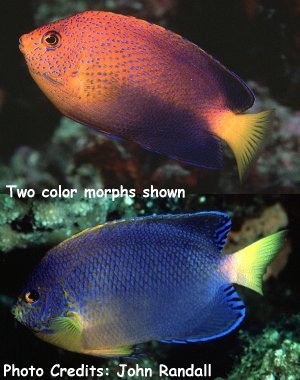
By Bob Goemans

Likely Reef Tank Suitable
Likely Fish-Only Tank Suitable
Range: Pacific Ocean: Southern Japan, Northwestern Hawaiian Islands, Kure and Midway Islands.
Size: 6 inches (15 cm)
Natural Environment: Inhabits rocky reefs containing boulders covered with heavy algae growth at depths between 25 – 200 feet (8 – 60 m).
General Husbandry: This beautiful dwarf angelfish, having a body that is basically an orange color with purple and blue spots and a tail that is bright yellow, is rarely seen in the hobby and when so, is quite expensive! An excellent browser of microalgae and detritus and as with most other species in this genus, a daily diet consisting of a wide variety of frozen foods including fortified brine shrimp, mysis, and flake food, especially Spirulina should suffice nicely. Nevertheless, since this is a rarely collected species, and travels a far distance to an owner’s aquarium, recommend when first introduced into the aquarium, preferable a well-established reef or fish-only aquarium where it can browse rock surfaces and crevices for various kinds of nutritional foodstuffs, it be offered several daily feedings so as to quickly acclimate to its surroundings. Also take note this species comes from waters that are slightly cooler than what most hobbyists maintain their aquariums, i.e., high 70’s to low 80’s. Therefore, consider somewhat lower aquarium temperatures, possibly low to mid 70’s if wanting to maintain a ‘wild caught’ specimen. Nevertheless, there are some specimens acclimated to warmer temperature waters becoming available, nevertheless, its wise to ask ‘what temperature water’ your desired specimen is coming from.
Can be quite shy when first entering the aquarium, and will hide in caves and crevices. But as time passes, will become more outgoing and begin to establish its territory. Yet keep in mind they are not suited for small nano style aquariums, as they are one of the larger species in this genus and will not only become quite aggressive in small aquariums, they will, without numerous feedings per day, be able to find enough food to be maintained long-term. Also keep in mind only one species from this dwarf angelfish genus should be in the aquarium, as they will develop aggression to other dwarf angelfish species.
Taxonomy:
Order: Perciformes
Suborder: Percoidei
Family: Pomacanthidae
Genus: Centropyge
FYI: All Centropyge species start life as unsexed individuals, but begin their adult life as females. Then, the larger or more dominant individual within small groups will change sex within a few days to a couple of weeks and become a male. Knowing that size is the main difference between the sexes, and not so much its coloration, all one needs to do is place a small and larger specimen together. Within approximately sixty days one of the two fish will have physically changed sex to accommodate the other. A reversal of this sex change is possible if the need arises, but that requires much more time, e.g., weeks to months.
Keep in mind all angels have cheekspines at the edge of their gill cover; therefore use caution when handling and also avoid using a net to capture it, as it may become stuck or tangled in the net and become damaged when removed.
Captive-bred specimens are slowly becoming available and easy to keep (C. Delbeek, per.com.).
Experience Level: Intermediate
Temperament: Semi-aggressive
Diet: Omnivore
Acclimation Time: 30 minutes+
Aquarium Environment: Reef or Fish-only aquarium
Reef Safe: With caution – underfed specimens have a tendency to nip clam mantles, sea anemones, large–polyped stony (LPS) corals and some soft corals such as zoanthids.
Minimum Tank Size: 50 gallons
Temperature Range: 66 - 75°F (19 – 24°C).
Specific Gravity: 1.020-1.027
pH: 8.0 - 8.5
